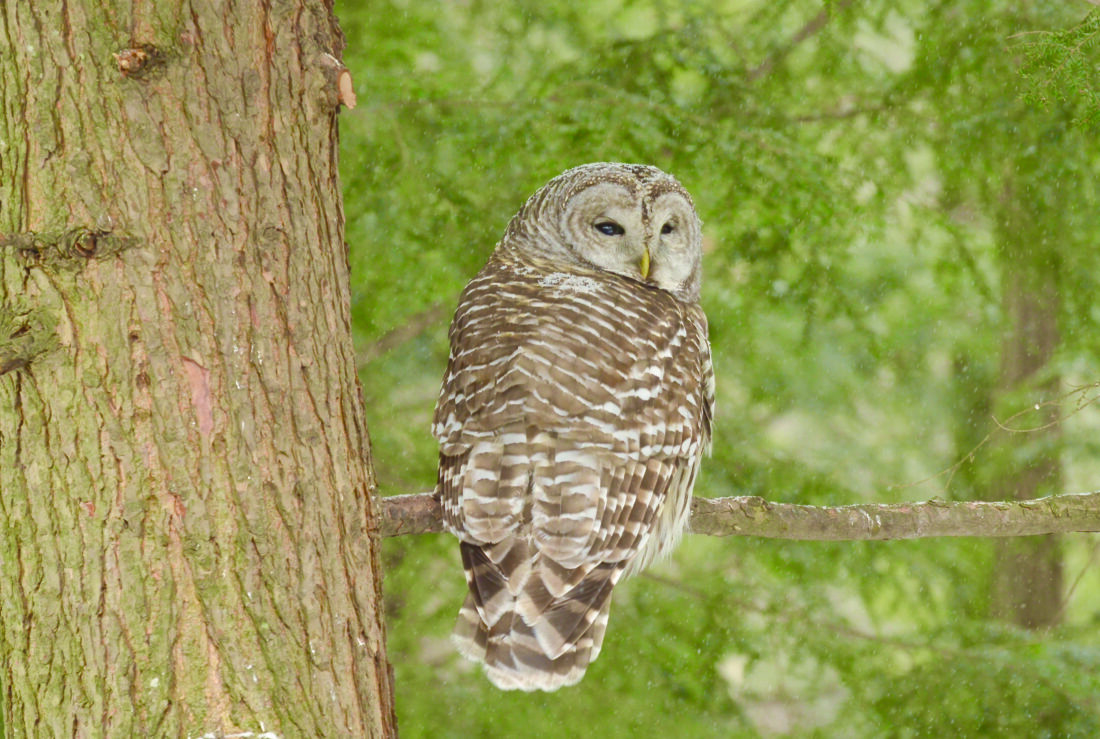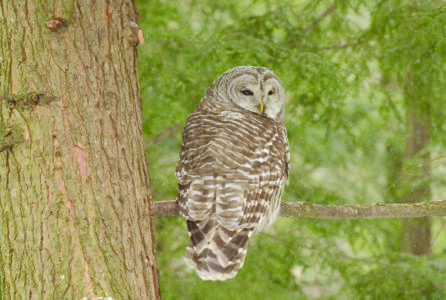What’s Flying: How can the October sunshine get any better?

A barred owl looks on. (Scot Stewart photo)
“You don’t waste October sunshine. Soon the old autumn sun would bed down in cloud blankets, and there would be weeks of gray rain before it finally decided to snow.” — Katherine Arden, Small Spaces
Although the two weeks of sunshine just passed were a welcome fall blessing, the need for a bit of rain was clear. Autumn leaves began curling up and falling off prematurely. A sudden hailstorm reportedly took all the leaves from a small area in eastern Baraga County recently too.
Sunshine has not been wasted on migrant birds either. They seem to be continuing their travels southward and the cooler weather has coincided with large movements of ducks now turning up across the entire Upper Peninsula.
In Marquette some divers have been seen in the Lower Harbor. Eighteen were observed on Monday and appeared to all be redhead ducks. On Wednesday a birder at Presque Isle Park in north Marquette found over 600 ducks including northern pintails, green-wing teals, wood ducks, mallards, surf scoters, greater scaup, and red-breasted mergansers. While some were at close range, nearly 500 were at a distance and not identifiable to species.
The Lower Harbor should have erratic flocks of diver ducks moving in and out through the next month or two. The bay area in front of Founders’ Landing is a great place to start looking but better close-up looks at ducks and grebes will come between the pier areas and close to the ore dock.

SCOT STEWART
On AuTrain Lake in Alger County, blue-winged teal, American wigeons, mallards, black ducks, and ring-necked ducks were among the nearly 400 seen last Monday. But for some of the best ducks, there is nothing like a little more time at Whitefish Point in Chippewa County where the waterbird counter and others there counted over 3000 ducks flying past the point this past. Tueday! Highlights included 1010 redheads, 289 American wigeons, and 660 scaup species. 77 common loons and a Sabine’s gull were two of the other great finds for the day there.
Back to the Dead River in Marquette, birders found that trumpeter swans have turned up again. Four were seen at the west end of Tourist Park Lake. The quartet consisted of two adults and two full-sized juveniles. The juveniles were as large as the adults but were not fully white. Most trumpeters usually get their adult, full-white plumage during their second summer. They may begin pairing during their second year but usually don’t begin nesting until they are between the age of three and six. The oldest known trumpeter swan was 26 years old, found in Wisconsin. In captivity, they have been known to live past the age of 30.
Trumpeters have appeared on the Dead River at various times during each of the last four years in Marquette, but evidence of them nesting in Marquette has not been found. They often spend time above the Tourist Park Lake, frequently checking on shoreline activity, and are not beyond moseying up around bird feeders for corn and sunflower seeds. They also have been seen spending long hours dabbling in the shallows of the “Dead River Marshes” just above the Lakeshore Blvd. bridge foraging for aquatic plants in the shallows around the mallards. Their appearances have not seemed to follow any sort of pattern, and their stays have not been of a regular time.
During summer months trumpeter swans in the U.P. remain close to a summer range and in winter here usually end up migrating farther south or have at least moved to an area with year-round open water. Preferred spots have included the Manistique River near Indian Lake in Schoolcraft County and Trout Lake, a spring fed lake in Alger County south of Chatham. Although they have been on the Dead River in winter, they have not stayed on the river for any sizeable period during colder weather.
Birding reports from across the area continue to turn up lots of lingering birds. Sandhill cranes, Wilson’s snipes, and lots of palm and yellow-rumped warblers are still working through the area. One species being seen on many checklists is the golden-crowned kinglet. A dozen or more were on several Presque Isle counts this week.
These small relatives of the thrushes are one of the hardiest birds in the U.P. Smaller than chickadees and often seen in winter flocks with them and downy woodpeckers, they spend their days working through the upper branches of trees looking for larvae of a variety of insects. It seems like just about the coldest and most dangerous places to be in frigid weather but studies in New England looked at tops of trees cut down in winter and found they contained surprising number of overwintering insects.
This past week held some other surprises in the afternoon sun. A quintet of common grackles was found visiting sunflower and suet feeders in Marquette on Wednesday. Usually, they are packed up and on their way south from the U.P by the beginning of September but many stayed later here. It not certain if these were migrants or not, but few have reported in the past week or so before this.
It is a great time to get out for some fresh air and fall colors and can be topped off with chatty birds off in the forest. Red-bellied woodpeckers had much to say across Presque Isle this past Wednesday morning, and last Sunday a pair of barred owls had a brief conversation out near Harlow Lake.
- A barred owl looks on. (Scot Stewart photo)
- SCOT STEWART



